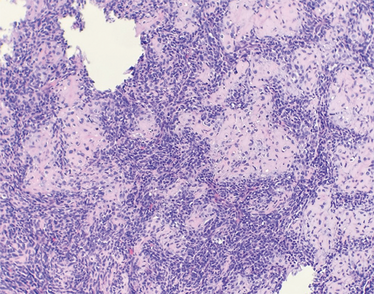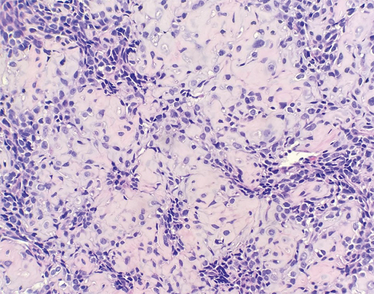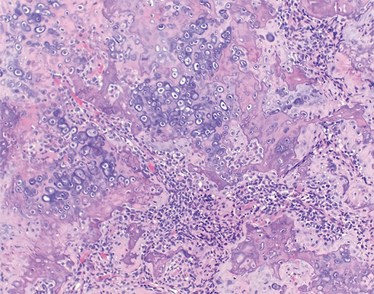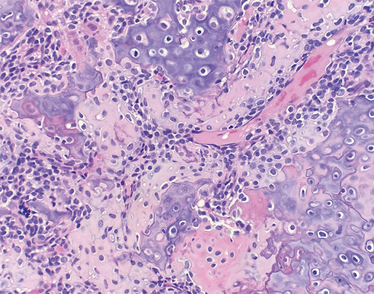Case of the Month
A 24-year-old woman presents with a mass of the pelvic soft tissue. Histologic images are shown. What is the most common genetic finding in this distinctive tumor?
a. IRF2BP2-CDX1 fusion
b. EWSR1-FLI1 fusion
c. t(11;12)(q24;q12)
d. HEY1-NCOA2 fusion
Submitted by Megan C. Smith, Resident in Anatomic and Clinical Pathology, Vanderbilt University Medical Center, Department of Pathology, Microbiology, and Immunology, Nashville, TN, USA.
Click here to register your guess.
Do you have an interesting case that you would like us to feature? Email it to [email protected].
Answer to November/December's Case of the Month
D. vaginal adenosis
Histologically, the vagina is made up of stratified squamous epithelium, lamina propria, a smooth muscle layer, and adventitia which connects with bladder (anteriorly) and rectum (posteriorly). The lamina propria should not have any glands, unlike this case that has simple cuboidal, endocervical-type glands, consistent with vaginal adenosis. On colposcopy, vaginal adenosis can appear as red, granular mosaic patches but fails to stain with iodine solution (1). Vaginal adenosis may arise de novo or due to prenatal diethylstilbestrol (DES) exposure in pregnant mothers who were prescribed this synthetic estrogen during the mid-20th century to prevent miscarriage (2). An estimated 5–10 million US citizens have received DES either during pregnancy or in utero (3). When women less than 30 years old were diagnosed with vaginal and cervical clear cell adenocarcinoma (CCA), a link was made with this rare carcinoma and DES exposure (4). Vaginal adenosis is considered a non-obligate precursor of vaginal and cervical CCA affecting between 34–88 percent of DES-exposed women (4, 5, 6, 7).
The differential diagnosis of vaginal adenosis includes endometriosis of the vaginal wall (a CD10 or IFITM immunohistochemical marker) may help in staining the endometrial stroma. Another differential includes a vaginal inclusion cyst, although the more superficial location and clinical physical examination can help differentiate it from vaginal adenosis, which occurs predominantly in the upper third of the vagina (1). A third differential includes CCA, which presents with necrosis, greater architectural complexity – such as papillary structures – and cytologic atypia with prominent nucleoli, increased mitotic activity, and hobnailing (4, 8).
Submitted by Jay Hwang and Cole Biehl, Department of Pathology and Laboratory Services, Brooke Army Medical Center, San Antonio, Texas, USA.
- HK Haefner & CP Crum, “Benign conditions of the vagina,” InDiag Gynecol Obstet Path, 258 (2018).
- EE Hatch et al., “Preterm birth, fetal growth, and age at menarche among women exposed prenatally to diethylstilbestrol (DES),” Reprod Toxicol, 1, 31, 151 (2011). PMID: 21130156.
- RM Giusti et al., “Diethylstilbestrol revisited: a review of the long-term health effects,” Ann Intern Med, 122, 778 (1995). PMID: 7717601.
- AL Herbst & RE Scully, “Adenocarcinoma of the vagina in adolescence. A report of 7 cases including 6 clear-cell carcinomas (so-called mesonephromas),” Cancer, 25, 745 (1970). PMID: 5443099.
- DA Antonioli & L Burke, “Vaginal adenosis. Analysis of 325 biopsy specimens from 100 patients,” Am J Clin Pathol, 64, 625 (1975). PMID: 1190123.
- RH Kaufman & E Adam, “Genital tract anomalies associated with in utero exposure to diethylstilbestrol,” Isr J Med Sci, 14, 353 (1978). PMID: 640820
- PC Brien PC et al., “Vaginal epithelial changes in young women enrolled in the National Cooperative Diethylstilbestrol Adenosis (DESAD) project,” Obstet Gynecol, 53, 300 (1979) PMID: PMID: 424101.
- AG Hanselaar et al., “Clear cell adenocarcinoma of the vagina and cervix. A report of the Central Netherlands Registry with emphasis on early detection and prognosis,” Cancer, 1, 67, 1971 (1991). PMID: 2004313.
Resident in Anatomic and Clinical Pathology, Vanderbilt University Medical Center, Department of Pathology, Microbiology, and Immunology, Nashville, Tennessee, USA.
























